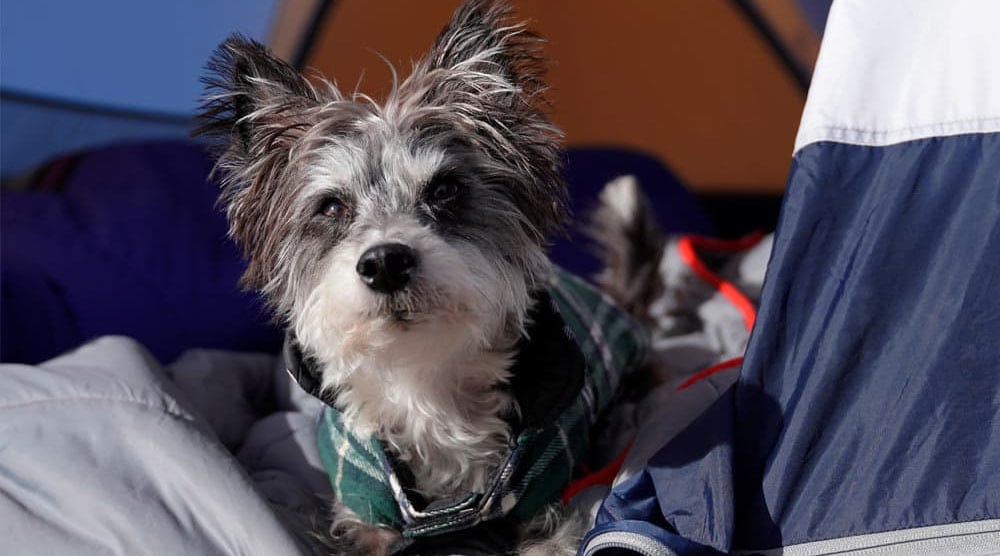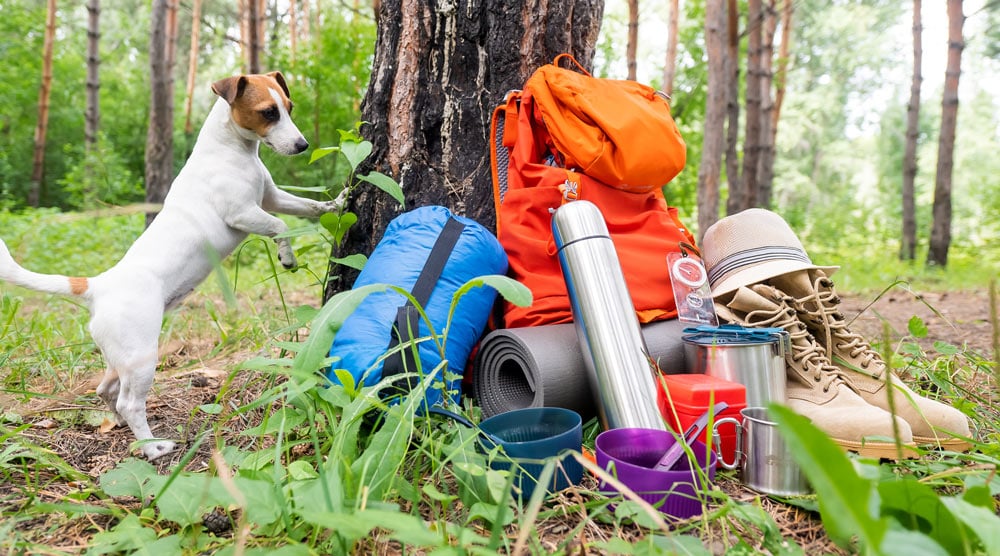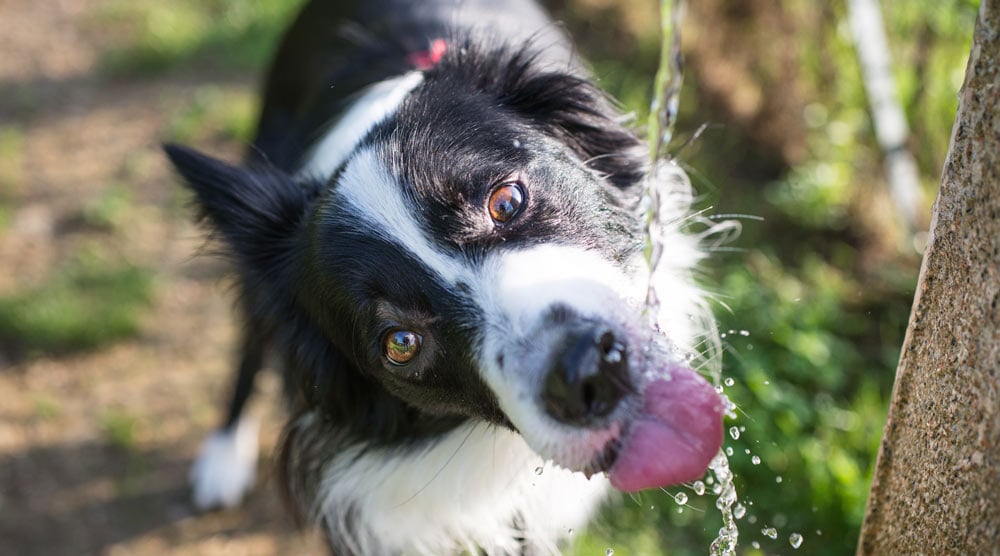Overheating is a common problem when camping with dogs, but our canine companions can also get too cold – especially at night. Here are eight tips for keeping your dog warm and comfortable.
Contents
It’s essential to keep your pet at the right temperature though. Nights can be bitterly cold – even in the summer. And if you’re camping in non-summer seasons, the temperatures can be dangerously cold throughout the day.
Here are some tips for keeping your dog warm and safe on your next camping trip.
Symptoms of a Cold Dog
A dog’s tolerance for cold weather varies, so it’s important to know the most common warning signs.
Some dogs have been bred to tolerate the cold more than others. Arctic breeds, such as huskies, have thick double coats to keep them warm, although they can still get cold in low temperatures. Short-haired and thin breeds, such as greyhounds, get cold in relatively mild weather.
You also need to consider your dog’s coat length, age and health. Elderly dogs, puppies, and those with chronic health conditions all struggle in cold weather.
Depending on how cold your dog is, a variety of symptoms can manifest that you should look out for:
- Trembling
- Increased vocalisation, particularly whining
- Changes in body posture, usually hunched with a tucked tail
- Lethargic and reluctant to move
- Extremities, like your dog’s ears, feel very cold
- They may curl up and looking for a sheltered spot
If a dog is losing heat faster than it can warm up, hypothermia can set in. This is a life-threatening condition that should be avoided at all costs.
Initial signs of hypothermia include extreme shivering and drowsy behavior. Hiking in cold weather, or wet fur, can increase the chances of hypothermia.
The best way to avoid hypothermia is to ensure your dog is never in a dangerously cold situation. Check the weather before you go and make sure you kit them out in the right gear.
1. Check The Weather Forecast and Assess Your Dogs Health
You should always check the weather forecast before a camping trip.
For puppies and elderly dogs, who are naturally more susceptible to feeling the cold, it’s sensible to only take them camping if you know the weather is going to be mild.
The same goes for breeds that are not designed for cold climates. A sighthound with little body fat and a short single-coat will struggle to keep cosy in freezing conditions.
Health conditions, like heart disease, diabetes and Cushing’s, can also cause your dog to feel the cold more. If your dog has arthritis or other joint problems, the cold can aggravate this, and they’re more likely to be uncomfortable if they have to sleep in a cold environment.
Even if you’re a hardy adventurer, always put your dog’s needs first. If you think the conditions may be a problem for them, it may be better to cancel your trip or leave your dog at home with friends or a dog sitter.
Note: I always recommend taking your dog for a health check in advance of an extended camping trip. If you plan to camp during cold weather, you should mention this to your vet to get their opinion.
2. Let Your Dog Sleep in the Tent
Even if you have an arctic breed like a Husky, letting your dog sleep in your tent is recommended. The tent provides shelter from the elements and your combined body heat will help you stay warm. Sleeping in the same tent is also part of the bonding experience!
Your dog will also be safer inside the tent. Aside from the weather, a dog sleeping outside is at risk from theft or predators.
3. Create a Cozy Space for Your Dog
Lots of people think that letting their dog sleep beside them in the tent on the ground liner is enough.
Yes, they’re sheltered from the worst weather, but this isn’t a relaxing spot for your pet to spend the night. The hard ground will be uncomfortable to sleep on for a prolonged period, especially if your dog has joint issues.
It’s also much harder for your dog to stay warm on the cold floor. Make sure you provide warm bedding and consider elevating your pet off the ground. A cold-weather sleeping bag can be a good option as these are insulated and roll up into a compact shape. There are also portable camping beds specifically developed for dogs.
You may also want to pop a soft blanket underneath their bed, or even use an additional camping mattress for extra comfort and insulation.
If the weather is milder, make sure your dog has a cooler space in the tent to move to if they choose. You don’t want them to overheat either.
Tip: Want a more complete guide to camping gear for your pet? Read our dog camping gear checklist.
4. Buy a Warm Dog Jumper
Lots of people scoff at dogs wearing sweaters or jumpers, but they can be a practical option for keeping your dog warm – especially during cold nights.
If your dog hasn’t worn a jumper before, practice wearing it before your trip. Get them used to having it put on and accompany these fitting sessions with lots of yummy treats, so they associate it with good things.
Letting them use it in advance also gives you a chance to make sure it fits properly. It shouldn’t rub or restrict their movement.
5. Also Buy a Coat for Hiking
If you already have a good quality coat for your dog, you may be tempted just to use this in the tent too. The coat could be a great piece of kit for hiking, but it will likely be too bulky and uncomfortable when sleeping. Depending on the material, it could also be noisy when they move around.
Also, if it gets wet when you’re out hiking, you’ll want something dry for your dog to wear when you get back at the end of the day.
Always make sure the coat is fully dry before putting it back on your dog. A soaked through coat could cause your dog to get even colder, and it can also increase the chance of it rubbing and aggravating their skin.
6. Consider Increasing Your Dog’s Food
Several studies have shown a dog’s calorie intake should be increased when exposed to low temperatures over a prolonged period, especially when exercising more.
So, if you’re planning an active multi-day winter hiking trip, your dog may benefit from having their daily food rations increased.
A study by Blaza in 1982 suggested that a 25% increase in food intake was needed for the Labradors and Beagles in the study when the temperature dropped from 15 to 8℃.
Of course, you shouldn’t up their food intake too drastically, as a sudden large change could upset your dog’s tummy, and this wouldn’t be ideal for either of you when you’re away on a trip.
7. Make Sure Your Dog Stays Dry
One of the most important things for ensuring your dog stays cozy, is to make sure they stay dry. Prolonged wet fur can greatly increase the chances of your dog feeling the cold, and in very extreme temperatures, it can put them at higher risk of developing hypothermia.
Certain breeds have coats that absorb and hold moisture more, and their coats can take longer to dry out.
Using a good quality waterproof coat, and sometimes even a fleece sweater liner underneath, can help. If your dog is a water lover, try to keep them out of the water, or at least bring towels so you can dry them off as well as possible.
You might even want to fill a bottle with hot water to help keep your dog feeling extra cozy while their coat dries out. Just make sure it’s one that is designed to carry hot water (the Nalgene bottles are a good choice), and that the water isn’t so hot it could burn your dog through the bottle. You could also wrap it in a towel or blanket.
If it’s raining at night when your dog needs a potty break, pop their jacket on and take it off when re-entering. Leaving them in a wet coat will only make them feel colder.
8. Cuddle for Warmth!
If your dog loves to snuggle, don’t discourage this in the tent. Huddling together can generate more body heat, and this will help you both to stay cozy. And, who doesn’t love cuddles from their dog, right?
Of course, not every dog likes to be cuddled. Don’t force your dog to come in beside you if they prefer to have space.
Summary
If you want to keep your dog cozy on a camping expedition, make sure you’re prepared.
Check the forecast, and rethink your plans if the weather is extreme. Take into consideration your dog’s breed type, health and age. Not all dogs cope in cold weather.
Make sure there’s room for your dog to sleep with you in the tent, that they have a cozy bed and blankets, and that you have a doggie sweater if they’re particularly susceptible to the cold.
Keep them as dry as possible and don’t forget to stock up on extra food for a multi-day expedition. Remember, if your dog is cold or more active than usual, he may need a bit more food.




